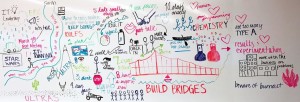Long Distance Information Technology
Running long distances can be treacherous. So can IT. In the first IT leadership meeting of 2016 Eric Buckley told us how to survive both. An ultra-runner who often runs 100 mile marathons through dangerous terrain and conditions, Eric is well-versed in overcoming obstacles. In his presentation he shared the similarities between ultra running and all-encompassing, long distance information technology projects.
Rule 1: have a realistic plan
It is best to navigate your path at the beginning so you can make realistic estimates of effort, cost, etc. Don’t forget to pace yourself—the process will be too long so recovery has to happen throughout.
Rule 2: take walking breaks
At 40-45 miles, an ultra runner’s running pace hits the slowest they’ll ever run so at this point, alternate between running and walking to keep up pace and energy. It is helpful to consider 3-4 week iterations with periodic checkpoints/breaks to refresh the team and remember the end goal.
Rule 3: keep moving
Never stop or you will lose momentum; definitely don’t sit down. Project manager should look ahead and make sure the team is occupied and hopeful.
Rule 4: run fast
When you are running, run fast to avoid sloppy, slow movement. Energy is based on the steps you take, not the speed at which you take them. How can you keep your team positive when the end is so far away?
- Avoid repetitive tasks; allow employees to work on their interests every so often
- Showcase the team’s work with demos throughout to remind them of the goal
Rule 5: take small steps
If you can’t decide between taking 1 step or 2 steps, take 3 because small corrections are much easier to manage than large ones. Don’t let team members bite off more than they can chew.
Rule 6: refuel
Breaks and boundaries are important so make sure to incorporate both. Food is necessary but so is efficient time management; grab what you need and get back on the trail. Don’t give your team members special rules; if the rest of the company gets 3 weeks of vacation time, so should your project team (this project shouldn’t feel like it is making the team worse off).
Rule 7: expect setbacks
Setbacks are inevitable but a strong, motivated, connected team can get through them. Attention to detail is crucial.
Rule 8: have a support crew
Build bridges from the beginning in case you need help later; early communication and seeking input are great facilitators for a good relationship If you have a problem, ask for help immediately because the purpose of the steering committee is to be there.
Rule 9: have a pacer
Have someone there to help you whenever you need it i.e. from miles 50-75 when you see no end…it also helps to make friends in high places Your pacer could be a mentor with whom you have a confidential and trusting relationship
Rule 10: staff wisely
The rock star may not always be best for long IT projects so it helps to look for humility, a sense of humor, perseverance, someone you enjoy being around, someone who won’t quit. Within the project team, the environment should be collaborative not competitive. Make sure your systems are maintainable throughout and after the process.
In summary: running ultramarathons and long distance information technology projects require planning, perseverance, and support. IT Project managers should be aware of their team’s morale throughout the entire process and pace themselves for a successful run.
Check out more on Eric’s blog http://never2old4school.blogspot.com/






